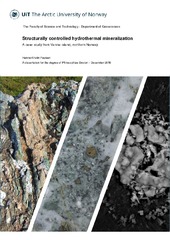| dc.contributor.advisor | Palinkas, Sabina Strmic | |
| dc.contributor.author | Paulsen, Hanne-Kristin | |
| dc.date.accessioned | 2020-03-02T10:24:37Z | |
| dc.date.available | 2020-03-02T10:24:37Z | |
| dc.date.issued | 2020-02-27 | |
| dc.description.abstract | The formation of metal and mineral deposits is closely related to the tectonic setting in which they form. Structures create avenues of net permeability that allow ore-bearing fluids to transport and deposit mineralization. In a deeper crustal setting these structures can be ductile shear zones, while brittle faults and fractures are the dominant fluid pathways in the upper continental crust. This work focusses on the metallogeny of Vanna, an island located in the northern part of the Archaean to Palaeoproterozoic West Troms Basement Complex in northern Norway. The complex is a part of the north-western margin of the Fennoscandian Shield, which is the most prolific mining area in Europe. Paper I investigates the prolonged and multiphased deformation history Vanna and documents several episodes of crustal extension and compression. Normal faulting during the 2.2-2.4 Ga extension created rift basins that subsequently became inverted during the accretionary Svecofennian orogeny (c. 1.8-1.7 Ga), and resulted in the formation of low-grade fold and thrust belt structures in the basement rocks and metasedimentary cover sequences. This geological and structural framework outlined in Paper I forms the basis for understanding the metallogenic evolution of Vanna. In paper II we show that emerald mineralization formed by highly saline hydrothermal fluids that circulated in the Olkeeidet tectonic shear zone; a large, crustal scale dextral shear zone active during the contractile deformation. This highly saline hydrothermal fluid likely originated as a magmatic fluid and strongly Na/K metasomatised the host rocks, and deposited quartz-tourmaline veins, dolomite and emerald. Paper III investigates hydrothermal Cu-Zn mineralization hosted by the late-Palaeozoic brittle Vannareid-Burøysund fault. Here, highly saline fluids used the brittle fault as a fluid conduit. The subsequent deposition of Zn (sphalerite) first, and Cu (chalcopyrite) second also shows that the fault progressively evolved and widened with time. Considered together, the three papers in this thesis show that mineralization on Vanna is structurally controlled, and the results can be used to discuss the mineralization potential of the region more broadly. | en_US |
| dc.description.doctoraltype | ph.d. | en_US |
| dc.description.popularabstract | Vanna is an island located just northeast of Tromsø, and the rocks found on this island has recorded an unique geological history that spans almost 3 billion years. Multiple phases of shortening and extension of the earths crust resulted in several generations of faults and fractures in these low-grade basement rocks. This PhD project investigates the geological mechanisms that lead to the formation of small bright green emeralds, and much later copper-zinc mineralization. Although the emerald and copper-zinc occurrences differ in age and chemistry, both these mineralization events were formed by hot and salty (hydrothermal) fluids that used the faults and fracture systems as pathways through the otherwise impermeable crust. These hot fluids have picked up, transported and deposited the components that ultimately lead to enrichment of these valuable metals and minerals on Vanna. | en_US |
| dc.identifier.isbn | 978-82-8236-385-3 | |
| dc.identifier.uri | https://hdl.handle.net/10037/17568 | |
| dc.language.iso | eng | en_US |
| dc.publisher | UiT Norges arktiske universitet | en_US |
| dc.publisher | UiT The Arctic University of Norway | en_US |
| dc.relation.haspart | <p>Paper I: Paulsen, H.K., Bergh, S.G., Strmic Palinkaš, S., Karlsen, S.E., Kolsum, S., Rønningen, I.U. & Nasuti, A. Foldthrust structures and oblique faults on Vanna island, West Troms Basement Complex, and their relation to inverted metasedimentary sequences. (Manuscript). Available in the file “thesis_entire.pdf”.
<p>Paper II: Paulsen, H.K., Bergh, S.G. & Strmic Palinkaš, S. Hydrothermal emeralds: a shear zone hosted mineralization on Vanna Island, northern Norway. (Manuscript). Available in the file “thesis_entire.pdf”.
<p>Paper III: Paulsen, H.K., Bergh, S.G. & Strmic Palinkaš, S. Late Palaeozoic fault controlled hydrothermal Cu-Zn mineralization on Vanna Island, West Troms Basement Complex, northern Norway. (Submitted manuscript). | en_US |
| dc.rights.accessRights | openAccess | en_US |
| dc.rights.holder | Copyright 2020 The Author(s) | |
| dc.rights.uri | https://creativecommons.org/licenses/by-nc-sa/4.0 | en_US |
| dc.rights | Attribution-NonCommercial-ShareAlike 4.0 International (CC BY-NC-SA 4.0) | en_US |
| dc.subject | VDP::Mathematics and natural science: 400::Geosciences: 450 | en_US |
| dc.subject | VDP::Matematikk og Naturvitenskap: 400::Geofag: 450 | en_US |
| dc.title | Structurally controlled hydrothermal mineralization: A case study from Vanna island, northern Norway | en_US |
| dc.type | Doctoral thesis | en_US |
| dc.type | Doktorgradsavhandling | en_US |


 English
English norsk
norsk

